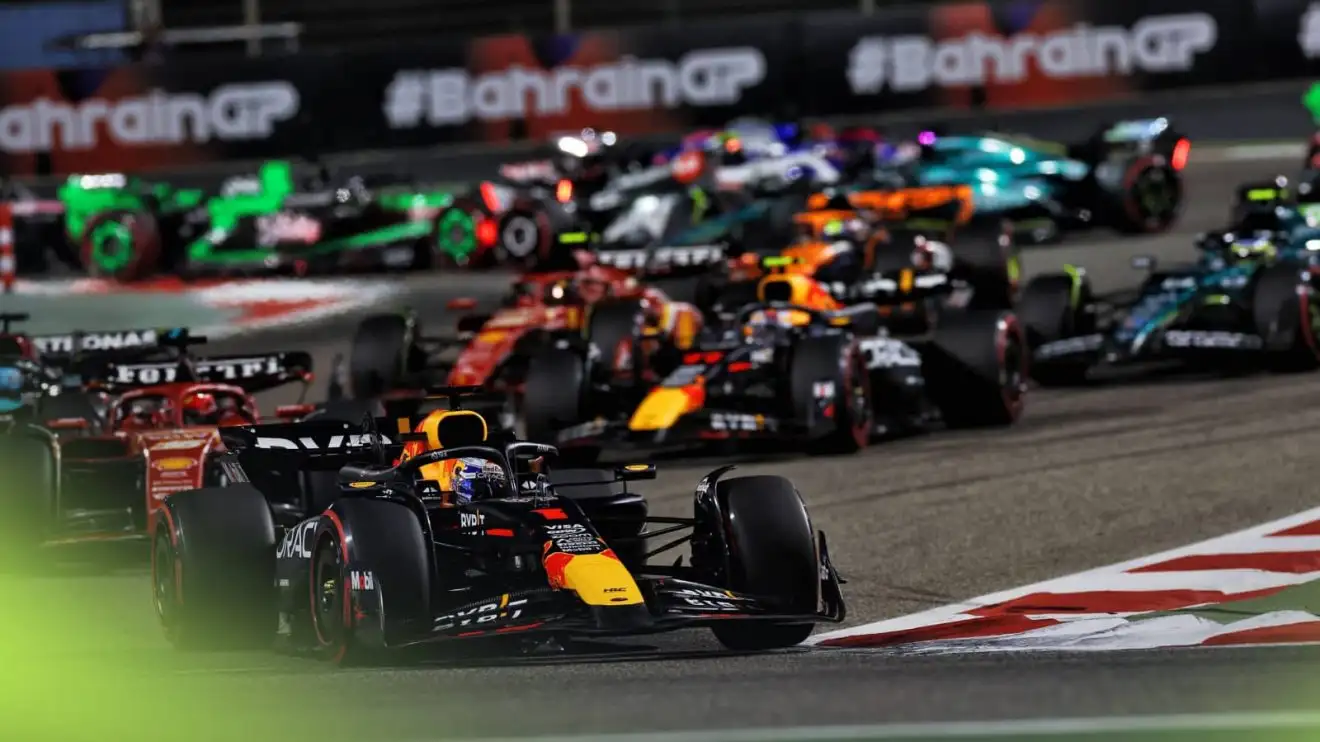F1 teams set for tougher front wing flex rules as new tests introduced
31 Jan 2025 3:30 PM

Max Verstappen’s Red Bull leads at the start of the 2024 Bahrain Grand Prix
The FIA is set to clamp down further on flexible front wings from the middle of the F1 2025 season.
Following on from learnings taken from monitoring the level of front wing flexing going on last season, the FIA is looking to introduce tougher measures to clamp down on the level of flexibility permitted.
FIA set to introduce tougher front wing flex tests
An updated version of the technical directive TD018, first issued in 2023, has been circulated to the teams ahead of the F1 2025 season.
The refreshed document will see the teams having to conform to more stringent front-wing checks, with these checks set to be introduced at the Spanish Grand Prix in June 2025.
Last year, the FIA embarked on a fact-finding mission to monitor the front and rear wings of several teams in a bid to understand whether its measuring equipment had fallen behind the ingenuity of the teams – given that every team passed every static load test.
As reported by the Italian publication Autoracer.it on Friday, the FIA has issued a technical directive aimed at making its static load tests more stringent.
Technical directives are not made public, but it’s reported that the permitted level of flex will be reduced from 15mm to 10mm.
At present, the FIA’s technical regulations state that, under the current load tests, the front wing must not flex by more than 15mm.
The changes to the TD come not long after the rear wing regulations were changed in an effort to eliminate grey areas such as the ‘Mini-DRS’ seen on McLaren’s MCL38 at the Azerbaijan Grand Prix.
“Following further analysis carried out by the FIA Single Seater Department after the conclusion of the 2024 season, we are committed to ensure that bodywork flexibility is no longer a point of contention for the 2025 season,” read a statement from the FIA.
“As part of this effort, we will be increasing the scope of rear wing tests from the start of the 2025 season, and additional front wing tests being introduced from the Spanish GP.
“This phased approach allows teams to adapt without the need to discard existing components unnecessarily.
“These adjustments are aimed at further refining our ability to monitor and enforce bodywork flexibility regulations, ensuring a level playing field for all competitors to promote fair and exciting racing.”
The modified tests will be introduced at the Spanish Grand Prix, in order to give the teams time to modify their front wing designs, if necessary.
More on the FIA and F1’s governance
👉 Explained: The real reasons behind the FIA’s new swearing guidelines
👉 Explained: Why FIA are taking back seat on McLaren and Mercedes front wings
Last year, efforts to understand the level of flexing going on began as the FIA fitted several cars with special cameras in order to monitor the flex, with the governing body making it clear that no team was engaging in any untoward practices.
But the very obvious flexing observable on television footage, which had Red Bull and Ferrari pointing out what the two teams felt was excessive flexing from rival teams McLaren and Mercedes, resulted in the FIA seeking greater understanding of the practice.
With the FIA not seeking to clamp down on existing practices during 2024, it left Ferrari boss Fred Vasseur annoyed as he felt his team had lost crucial development time relative to those engaging in greater levels of flex.
“There was frustration because at one stage we were waiting for the decision of the FIA when they installed the cameras [from the Belgian GP],” Vasseur said to Motorsport.com.
“We were convinced that it will go for the ‘no go’. And it went for the ‘go’! So probably we lost one or two months.
“It’s difficult because with the cost cap you have to make your choices. It means that if you are convinced that it won’t be allowed, and you have start to develop something, then it’s costing you a time in the wind tunnel. But it was our decision.”
With the FIA now taking steps to kerb the practice, FIA single-seater Nikolas Tombazis has spoken about how taking immediate action could have been a “knee-jerk reaction” given the different approaches each team had towards its front wing design.
“Because the front wing gets loaded in different ways, we cannot predict it easily in the regulations,” Tombazis said towards the end of the 2024 season.
“As no two wings have exactly the same loading pattern, it is very difficult to come with a proper test.
“So, as these rules have been around since 2022, we felt it was a bit knee-jerk to suddenly say that for 2025 we were going to change it, or indeed change something for 2024, but we are using this information we’re gathering to perhaps lead us to something a bit more effective for 2026.”
While the initial plan had been to hold off until next season, the prospect of teams engaging further in the practice has encouraged the governing body to seek a way to pursue a more immediate clampdown.
Read Next: Why motorsport is so critical in Cadillac’s plan to take over the auto market